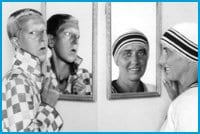
LOVER/OTHER. Barbara Hammer's latest feature doc on resistance fighters, artists and lovers Claude Cahun and Marcel Moore.
Barbara Hammer is the unrivalled éminence grise of lesbian avant-garde filmmaking, a woman who has fiercely struggled for more than four decades not only to transform how queers are represented in cinema, but also to revolutionize and push the boundaries of how queer artists envision themselves. Hammer’s oeuvre is being celebrated by a touring series of screenings, stopping for a week in Toronto, offering a unique chance to see where this pioneering artist has taken audiences over the years and where she is headed now.
Hammer’s inquisitive, experimental and politically progressive practice has often consigned her to the margins of not only the film world but the queer community as well. “The first time I ever showed my films publicly,” she says, “I showed them at a lesbian coffeehouse in Oakland, [California], and half the women walked out of the screening.” She soon found out that the walkouts were lesbian separatists who refused to see men and their penises on screen. “Half the work was heterosexual — I had started making films before I was gay. That was my first introduction to ‘lesbian community.'”
Hammer’s eclectic collage style was often just as confounding to audiences outside the avant garde as was her courageous exploration of all kinds of sexuality. “A lot of lesbians didn’t understand experimental work. They wanted straightforward work, and they wanted something to identify with, characters on the screen. I wasn’t interested in that, so I was never an overwhelming success.”
For Hammer, discussing the films with spectators and hearing their reactions has always been vital. “I was in Vienna in 1988…. I showed Multiple Orgasm. So there’s this huge clitoris on the screen, and this man’s voice yells out, ‘Aaah!’ He was in shock, he’d never seen anything so big and voluptuous. And the women yelled back at him, ‘If you don’t like it, leave!'”
Does Multiple Orgasm continue to shock some 12 years after it was made? “It still does,” she exclaims. The piece is part of the travelling exhibition Hidden Histories: The Art And Selected Films Of Barbara Hammer. Toronto audiences can see it in a program of her short films from the ’70s and ’80s, accompanied by the classic Dyketactics, the campy Menses and others (7pm on Sat, Jun 9 and 11).
The early films are considered to be among the first representations of lesbian experience by a self-identified lesbian artist. They are playful and daring and produced on the cheap. Hammer would often use her own body and those of her friends, building the films from fragments collected throughout her life. They were about breaking things down and creating a new space for lesbians on the screen.
Hammer’s career is divided between the earlier short experimental films and her later feature documentaries that delve into the archive of cultural history to uncover hidden queer lives and identities. This phase started with Nitrate Kisses (1992, available on VHS), which is a kind of manifesto for all her later historical work. The features are not only about research but also about rescuing a “usable past” of queer desire and struggle, making sure that no elders are consigned to the dustbin. She takes their phantoms from old celluloid and breathes new life into them.
Did the transition to features stem from a feeling that the explorations of her own queer body had reached an end point? “It was partly that and partly wanting to have other people’s bodies in there in place of my own- lesbians in their 70s making love. I hadn’t reached the point where I had the wrinkles that they had and that’s what I wanted to celebrate. I’m not African-American, so [mine] wasn’t the body that needed to be represented.
“These were all areas of censorship that I wanted to put on the screen. And it was more interesting to look at other histories and other lives beyond my own. It was like writing a different kind of book and investigating something I knew nothing about, which was terribly exciting.”
This dual interest in her own body and thoughts, and the desire to represent a broader history and society gestures at the tension that is the crux of Hammer’s work: Between looking inward and looking outward, between personal reflection and the search for beauty, and fighting the system in solidarity with one’s comrades. (The archive, the diary and the editing suite can be lonely places, after all.)
The diptych of Resisting Paradise and Lover/Other is her profoundly moving examination of this productive friction. Both are about the capacity of artists to resist during World War II. In Resisting Paradise (9pm on Jun 11 and 7pm on Jun 13), Hammer sets out to discover how and why Henri Matisse continued painting in Provence while Jews were being deported and his entire family served in the Resistance. In Lover/Other (7pm on Jun 8, 10, 12 and 14), Hammer constructs a portrait of the lovers Claude Cahun and Marcel Moore, surrealist art photographers who lived in isolation on the Isle Of Jersey, actively resisting the Nazi occupation at great personal cost.
While Matisse’s ruminations on colour and light can easily be dismissed as decadent or even ghoulish considering the harsh reality outside his door, Hammer always keeps a balanced view. “If we don’t celebrate life, what’s the reason for being here? Roses are necessary along with the bread. It comes out in my work because I would like to be just doing roses, but you just turn on the morning news and you can’t. Somehow if we see beauty maybe we’ll want to protect it. Part of the purpose of art is the power of perception and the power of intellect in recognizing the discrepancies in the world.”
Resisting Paradise is particularly affecting due to the presence of Lisa Fittko (who passed away in 2005), a woman who led many refugees out of France to safety. “When I ask Lisa, ‘Wasn’t it strange to have war in this beautiful place?’ she doesn’t even answer my question. She was so immersed in trying to save her life and others. [With Jewish philosopher and refugee] Walter Benjamin walking over the Pyrenees [to Spain] — nobody’s exclaiming about the view!”
The film speaks to the thousands of artists and intellectuals currently struggling to imagine ways of fighting back against the political right. “It’s definitely about the wars that are going on now, and definitely the films reach out beyond the particular slice of war that I chose to look at. And yes, Lover/Other is an answer to Resisting Paradise in that it’s tidy, with two artists that are also resisters, and they fulfill my identity as a lesbian.
“So what does an artist do during a time of war? You make your art and you resist — and you make your resistance a form of art. That is the key… otherwise we’re just talking to ourselves.”
How does an artist like Hammer resist the despair that can come from our global, seemingly insurmountable state of emergency? “One way you resist it is you get involved in the work; once you sit down to edit or collect or write, you get absorbed. At that point we’re renewing ourselves with another kind of energy — rather than just beauty — we’re solving a problem. All art for me is solving a problem, and that’s just such a delight, to put yourself into one small area of the world that you can control. You can make this, you can make it happen; you’re challenged. That’s an element of why we don’t despair.”
And what of activism? “Primarily, I see my activism as my films, that if I put lesbian identities on the screen and question the representations that are being made today, if I make that work and people see it — if they don’t see it, it’s not activism.
“I actually have some serious health issues. If I were to talk about despair I would talk about that, and rising against it, too. I think my energies are more toward archiving my work, having it in order, placing it in institutions that will care for it and make it accessible. I want to finish a film I shot five years ago.”
What are the veteran artist’s thoughts on the mainstreaming of queer culture over the past decades? “Well it was clear it was going that way from the beginning. Like I said, all the lesbians wanted to have The L-Word [even 30 or 40 years ago]. They just wanted me to replace heterosexual identities with lesbian identities in the same structure, so you don’t really change the system. That’s not, to me, what a lesbian is about. A lesbian is rupturing, it’s breaking open ways to breathe anew.”

 Why you can trust Xtra
Why you can trust Xtra


